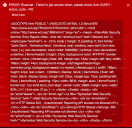Configuring MySQL Connectors
Connectors allow Stellar Cyber to collect data from external sources and add it to the data lake.
You can install a connector to the OpenDental MySQL database or another data source. There can be any number of MySQL connectors.
Connector Overview: MySQL
Capabilities
-
Collect: Yes
-
Respond: No
-
Native Alerts Mapped: No
-
Runs on: DP
-
Interval: Configurable
Collected Data
|
Content Type |
Index |
Locating Records |
|---|---|---|
|
SQL Result |
Syslog
|
Domain
N/A
Response Actions
N/A
Third Party Native Alert Integration Details
N/A
Required Credentials
-
Server Hostname or IP, Username, Password, and Database Name
Let us know if you find the above overview useful.
Adding a MySQL Connector
To add a MySQL connector:
Adding the Connector in Stellar Cyber
To add a MySQL connector in Stellar Cyber:
-
Log in to Stellar Cyber.
-
Click System | Integration | Connectors. The Connector Overview appears.
-
Click Create. The General tab of the Add Connector screen appears. The information on this tab cannot be changed after you add the connector.
The asterisk (*) indicates a required field.
-
Choose Database from the Category drop-down.
-
Choose MySQL from the Type drop-down.
-
For this connector, the supported Function is Collect, which is enabled already.
-
Enter a Name.
This field does not accept multibyte characters.
-
Choose a Tenant Name. The Interflow records created by this connector include this tenant name.
-
Choose the device on which to run the connector.
-
(Optional) When the Function is Collect, you can create Log Filters. For information, see Managing Log Filters.

-
Click Next. The Configuration tab appears.
The asterisk (*) indicates a required field.
-
Enter the Server Hostname or IP. This is the hostname or IP address of the MySQL server. If entering a hostname, do not include https.
-
Enter the Username of a user with read access to the database.
-
Enter the Password for that user.
-
Enter the Database Name. This is the name of the database on the MySQL server.
-
Enter the Select Columns that you want to ingest. Separate column names with commas, or enter * for all columns.
-
Enter the From Table. This is the table name in the database.
-
Enter the Where Condition. This is an optional query condition in MySQL syntax. If you do not want to use a condition, leave it blank.
-
Enter the Datetime Column. This is the column in the database containing the date and time information for the logs. The Datetime Column accepts epoch, mysql data type datetime, and timestamp.

-
Enter the Data Source. You can select OpenDental from the dropdown or enter another value, for example, a vendor.

-
Choose the Interval (min). This is how often the logs are collected.
-
Enter the Data Timezone. This is the timezone for the data stored in the MySQL database.
-
Choose the Content Type you would like to collect. The logs for SQL Result are supported.
-
Click Next. The final confirmation tab appears.
-
Click Submit.
To pull data, a connector must be added to a Data Analyzer profile if it is running on the Data Processor.
The new connector is immediately active.
Testing the Connector
When you add (or edit) a connector, we recommend that you run a test to validate the connectivity parameters you entered. (The test validates only the authentication / connectivity; it does not validate data flow).
For connectors running on a sensor, Stellar Cyber recommends that you allow 30-60 seconds for new or modified configuration details to be propagated to the sensor before performing a test.
-
Click System | Integrations | Connectors. The Connector Overview appears.
-
Locate the connector that you added, or modified, or that you want to test.
-
Click Test at the right side of that row. The test runs immediately.
Note that you may run only one test at a time.
Stellar Cyber conducts a basic connectivity test for the connector and reports a success or failure result. A successful test indicates that you entered all of the connector information correctly.
To aid troubleshooting your connector, the dialog remains open until you explicitly close it by using the X button. If the test fails, you can select the button from the same row to review and correct issues.
The connector status is updated every five (5) minutes. A successful test clears the connector status, but if issues persist, the status reverts to failed after a minute.
Repeat the test as needed.
Verifying Ingestion
To verify ingestion:
- Click Investigate | Threat Hunting. The Interflow Search tab appears.
- Change the Indices to Syslog. The table immediately updates to show ingested Interflow records.








